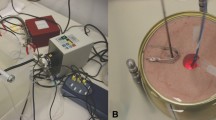Summary
Neodymion-YAG laser irradiation is a new and promising method for curative treatment of localized prostatic carcinoma. The laser light energy is transformed into heat within the tissue, and there is a risk of unintended damage to neighbouring organs. In seven patients the temperature in the rectal mucosa was monitored during the laser irradiation of the prostatic capsule. The temperatures did not increase to dangerous levels. According to a standardized irradiation procedure based on experiences gained in this study 47 patients have been treated without complications.
Similar content being viewed by others
References
Halldorsson T (1981) Biophysical fundamentals and instrumentation for the endovesical Nd:YAG laser application. Urologe A 20:293
Kronester A, Staehler G, Weinberg W, Keiditsch E (1981) Risk of intestinal damage from endoscopic Neodymion-YAG laser irradiation of bladder tumors. Urologe A 20:305
Sander S, Beisland HO, Fossberg E (1982) Neodymion-YAG laser in the treatment of prostatic cancer. Urol Res 10:85
Sander S, Beisland HO (1984) Laser in the treatment of prostatic carcinoma. J Urol (accepted for publication)
Author information
Authors and Affiliations
Rights and permissions
About this article
Cite this article
Beisland, H.O., Stranden, E. Rectal temperature monitoring during neodymion-YAG laser irradiation for prostatic carcinoma. Urol. Res. 12, 257–259 (1984). https://doi.org/10.1007/BF00256151
Accepted:
Issue Date:
DOI: https://doi.org/10.1007/BF00256151



